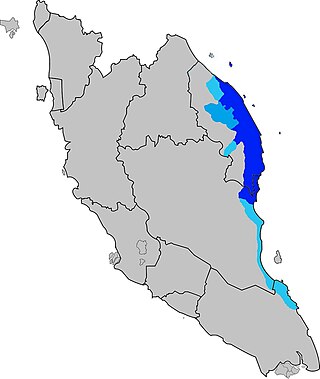
Back Terengganu Malay BCL Bahasa Melayu Terengganu ID Malayo Terengganu ILO Basa Malayu Trengganu JV Bahasa Melayu Terengganu Malay Malaio Trenganu Portuguese
| Terengganu Malay | |
|---|---|
| Base Tranung Bahasa Melayu Terengganu بهاس ترڠݢانو | |
| Native to | Malaysia |
| Region | Terengganu, Mersing and Tanjung Sedili (Johor), Kuantan (Pahang) |
| Ethnicity | Terengganuan Malay |
Native speakers | 1.1 million (2010)[citation needed] |
Austronesian
| |
| Dialects | Coastal Terengganu Inland Terengganu |
| Latin script, Arabic Script (Jawi) | |
| Language codes | |
| ISO 639-3 | – |
zlm-coa (coastal) | |
zlm-inl (inland) | |
| Glottolog | tere1283 |
| Linguasphere | 33-AFA-ca |
 Areas where Coastal Terengganu Malay is the majority language
Areas where Inland Terengganu Malay is the majority language
Areas where Terengganu Malay is a minority language | |
Terengganu Malay (Malay: Bahasa Melayu Terengganu; Terengganu Malay: Bahse Tranung/Ganu) is a Malayic language spoken in the Malaysian state of Terengganu all the way southward to coastal Pahang and northeast Johor. It is the native language of Terengganu Malays and highly localized Chinese Peranakan (locally known as "Mek and Awang") community as well as a second language among the smaller Indian minority.
The language has developed distinct phonetic, syntactic and lexical distinctions which makes it mutually unintelligible for speakers from outside the east coast of Peninsular Malaysia, especially those who speak Standard Malay/Malaysian.[1][2] Terengganu Malay still shares close linguistic ties with neighboring Kelantan and Pahang of which it forms under the umbrella term of "East Coast Peninsular Malayic languages" but maintain its own features distinct from both Pahang and Kelantan-Patani.[3][4]
Terengganu Malay also coexists with two closely related Malayic varieties. In the districts of Besut and northern part of Setiu, the majority of the population speak a variant of Kelantan-Pattani Malay, but in recent years many people from southern Terengganu started to migrate into these two districts and both variants now coexist with each other.[5] In the inland mukim of Pasir Raja, Dungun, several villages still speak a variant of Ulu Tembeling dialect of Pahang Malay, locally known as Pasir Raja dialect.[6]
Terengganu Malay is considered to be the most recognisable identity of the state. This can be seen in many local television dramas, movies, songs, poems and religious sermons[7] which emphasize the usage of Terengganu Malay.[8] Radio stations in Terengganu whether public (Terengganu FM) or privately owned (Hot FM and Molek FM) mainly use Terengganu Malay in its broadcast alongside standard Malaysian. Recent years show an increase of awareness of the uniqueness of Terengganu Malay, such as the increasing use of Terengganu Malay in shop signs and recently the publication of a Hulu Terengganu Malay dictionary.[9]
- ^ "Sustaining coastal terengganu malay dialect: An analysis on the linguistic features". ResearchGate. 2013.
- ^ "Malay". Ethnologue.
- ^ Collins, James T. (1989). "Malay Dialect Research in Malaysia: The Issue of Perspective" (PDF). Bijdragen tot de Taal-, Land- en Volkenkunde. 145 (2): 235–264. doi:10.1163/22134379-90003253. JSTOR 27864031.
- ^ Prof. Madya Ajid Che Kob. "Subklasifikasi Dialek Melayu Patani-Kelantan-Terengganu:Satu Analisis Kualitatif" (PDF) (in Malay).
- ^ Mohd Nasir Awang (7 July 2013). "Besut – Bumi Pertautan Dua Budaya". Gemersik Bayu Pantai (in Malay).
- ^ Hasrah, Mohd Tarmizi (2020). "Dialek Pasir Raja: Ciri Fonologi dan Pengelompokan". Jurnal Bahasa. 20 (2): 173–202. doi:10.37052/jb20(2)no1. S2CID 234391264 – via ResearchGate.
- ^ Junaini Kasdan (January 2018). "Dialek Terengganu dalam Penyampaian Dakwah: Analisis Sosiokognitif (Terengganu Dialect in Preaching of Da'wah: A Socio-Cognitive Analysis)". doi:10.17576/jatma-2018-0603-03 (inactive 1 November 2024).
{{cite web}}: CS1 maint: DOI inactive as of November 2024 (link) - ^ "Glosari Dialek Hulu Terengganu Dibukukan". TRDI News (in Malay). 17 July 2017. Retrieved 1 September 2020.